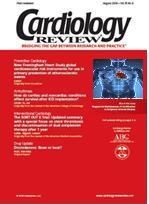Publication
Article
Cardiology Review® Online
Decreasing the risk of heart failure in a patient with hypertension and left ventricular hypertrophy
A 60-year-old man presented to his physician's office for a routine visit.
A 60-year-old man presented to his physician's office for a routine visit. He did not have any specific symptoms, chest pain, shortness of breath, palpitations, orthopnea, paroxysmal nocturnal dyspnea, or history of lower extremity edema. He had been told in the past that he had high blood pressure, but had always tried to manage it with diet and exercise, and was not taking any medication. He stated that his father had hypertension and heart failure.
His seated blood pressure was 170/100 mm Hg, with a pulse of 80 beats/minute. He had normal jugular venous pressure, and his lungs were clear on auscultation. He had a regular heart rate and rhythm, with no murmurs; a laterally displaced point of maximal impulse; and no lower extremity edema. Laboratory testing showed normal blood chemistries and complete blood count. An electrocardiogram (ECG) showed normal sinus rhythm at a rate of 80 beats/minute, normal axis deviation, no evidence of prior myocardial infarction, and left ventricular hypertrophy (LVH) by Cornell voltage-duration product criteria (R in aVL of 12 mm, S in V3 of 18 mm, and QRS duration of 100 msec; Cornell voltage-duration product of 3,000 mm·msec).
The patient was started on losartan (Cozaar) 50 mg daily with the addition of hydrochlorothiazide (Hydrodiuril, Microzide, Oretic) 12.5 mg in 1 month, and his blood pressure decreased to 130/80 mm Hg. An ECG performed at 1 year follow-up showed a Cornell voltage-duration product of 2,538 mm·msec (R in aVL of 11 mm, S in V3 of 16 mm, and QRS duration of 94 msec).
According to the results presented in the Losartan Intervention For Endpoint reduction in hypertension (LIFE) study, this patient should have a 36% lower likelihood of developing heart failure compared with a patient who did not have a regression in Cornell voltage product of at least 236 mm·msec. This patient should be continued on his blood pressure regimen and receive annual ECGs to monitor for further reduction in LVH, thereby decreasing the likelihood of heart failure.






